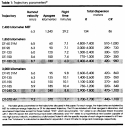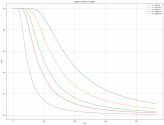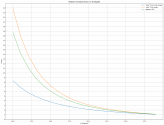Just look at the number of DF-41 and DF-31AG launchers in last national day parade, coupled with those recently satellite revealed ICBM silos, it can't be easier to understand number of China's nuclear warheads which can hit any location in the North America continent is already far beyond 1000.I do not obviously but I believe it is fairly easy to conclude.
China had roughly 300 active warheads by its own admission and foreign estimation around the end of the 1980s. We won't speculate on yield of warheads but lets assume city busters since - total number is relatively low, no real regional targets then that would require some sort of MAD.
Since 1990 China's economy has 50x. Industrial ability immeasurably improved.
MIC and no. of long range and IRBM (for regional targets up to and including most of north Africa) have increased.
Annual training and exercise expenditure of ballistic missile firing increased.
Tensions and security concerns increased. Hostility from US increased since 1990.
Nuclear reactor no.s (esp breeder type and refinement facilities) would only have increased over time even if older ones decommission.
Lifespan of Yu-Min warhead configuration design allows for longer lifespan as far as it is speculated.
You are using an out of date browser. It may not display this or other websites correctly.
You should upgrade or use an alternative browser.
You should upgrade or use an alternative browser.
China ICBM/SLBM, nuclear arms thread
- Thread starter Blitzo
- Start date
The People’s Liberation Army Rocket Force (PLARF) and China’s Nuclear Deterrence Capabilities Have Grown Considerably in the Past 15 Years.
Originally, the PLARF was constructed as purely a delivery force for China’s nuclear weapons. However, that role has expanded dramatically in recent decades to include conventional missile launch and nuclear co-mingling. The PLARF has also increased in size, with the number of launch brigades increasing from 22 to 41 since 2005. In 2021, China began construction of at least three large ICBM silo fields, which will increase the number of silos under the PLARF’s command. Further, the PLA has diversified its delivery systems for nuclear deterrence. These systems now include mobile launch options, silo-based missiles, submarine-launched ballistic missiles, and possibly air-launched nuclear ballistic missiles.
Recently, I came across this article which analyzed the counterforce capability of DT SLBM, specificially trident D5-II, against hardened silo targets.
The most important takeaway, which I don't think has been discussed on the forum before, is the MASSIVE accuracy penalty for the RV when fired in a depressed trajectory.

As shown above, the range (R) and cross-range (CR) dispersion can increase by more than an order of magnitude when fired in a depressed trajectory. CEP can be approximated by CEP=0.59*(R+CR).
I modeled single-shot kill probability(SSKP) using the model from with the 450kt W88 warhead for a range of CEP and silo hardness values.

This suggests that appropriately hardened Chinese ICBM silos (e.g. 10,000 psi, red line above) are very survivable against existing depressed trajectory trident counterforce strike fired from the Indian Ocean. In fact, it is very likely that the hardening level of the new Chinese silos are designed specifically to be survivable against DT SLBMs.
The inaccuracy is due to an RV having to travel through more atmosphere when reentering at a shallower angle. According to the paper, the range inaccuracy is proportional to 1/sin^3(a) and the cross-range inaccuracy is proportional to 1/sin^2(a).

Using this, it is possible to approximate the accuracy penalty due to depressed reentry angles relative to a normal minimum energy/maximum range trajectory reentry angle of 30 degrees (which corresponds to a CEP of 100m).
It is possible for the US to correct the atmosphere induced inaccuracy and vastly improve CEP by designing a maneurvering RV. However, this would require flight tests and cannot be deployed quickly.
The most important takeaway, which I don't think has been discussed on the forum before, is the MASSIVE accuracy penalty for the RV when fired in a depressed trajectory.

As shown above, the range (R) and cross-range (CR) dispersion can increase by more than an order of magnitude when fired in a depressed trajectory. CEP can be approximated by CEP=0.59*(R+CR).
I modeled single-shot kill probability(SSKP) using the model from with the 450kt W88 warhead for a range of CEP and silo hardness values.

This suggests that appropriately hardened Chinese ICBM silos (e.g. 10,000 psi, red line above) are very survivable against existing depressed trajectory trident counterforce strike fired from the Indian Ocean. In fact, it is very likely that the hardening level of the new Chinese silos are designed specifically to be survivable against DT SLBMs.
The inaccuracy is due to an RV having to travel through more atmosphere when reentering at a shallower angle. According to the paper, the range inaccuracy is proportional to 1/sin^3(a) and the cross-range inaccuracy is proportional to 1/sin^2(a).

Using this, it is possible to approximate the accuracy penalty due to depressed reentry angles relative to a normal minimum energy/maximum range trajectory reentry angle of 30 degrees (which corresponds to a CEP of 100m).
It is possible for the US to correct the atmosphere induced inaccuracy and vastly improve CEP by designing a maneurvering RV. However, this would require flight tests and cannot be deployed quickly.
Interesting. This means that a first strike against the silos will definitely be detected by OTH radars. So LoW does not require launch detection/IR warning satellites?Recently, I came across this article which analyzed the counterforce capability of DT SLBM, specificially trident D5-II, against hardened silo targets.
The most important takeaway, which I don't think has been discussed on the forum before, is the MASSIVE accuracy penalty for the RV when fired in a depressed trajectory.
View attachment 127123
As shown above, the range (R) and cross-range (CR) dispersion can increase by more than an order of magnitude when fired in a depressed trajectory. CEP can be approximated by CEP=0.59*(R+CR).
I modeled single-shot kill probability(SSKP) using the model from with the 450kt W88 warhead for a range of CEP and silo hardness values.
View attachment 127124
This suggests that appropriately hardened Chinese ICBM silos (e.g. 10,000 psi, red line above) are very survivable against existing depressed trajectory trident counterforce strike fired from the Indian Ocean. In fact, it is very likely that the hardening level of the new Chinese silos are designed specifically to be survivable against DT SLBMs.
The inaccuracy is due to an RV having to travel through more atmosphere when reentering at a shallower angle. According to the paper, the range inaccuracy is proportional to 1/sin^3(a) and the cross-range inaccuracy is proportional to 1/sin^2(a).
View attachment 127128
Using this, it is possible to approximate the accuracy penalty due to depressed reentry angles relative to a normal minimum energy/maximum range trajectory reentry angle of 30 degrees (which corresponds to a CEP of 100m).
It is possible for the US to correct the atmosphere induced inaccuracy and vastly improve CEP by designing a maneurvering RV. However, this would require flight tests and cannot be deployed quickly.
I am not sure how you conclude this since OTH radars work by bouncing HF radio waves off the ionosphere, and as such cannot be used to detect objects outside the atmosphere, like mid-course phase ballistic missiles including DT SLBM with an altitude of ~120km. China already has GEO EW satellites.Interesting. This means that a first strike against the silos will definitely be detected by OTH radars. So LoW does not require launch detection/IR warning satellites?
My point is that the US cannot execute a first strike with a high likelihood of success with its existing DT SLBM capability.
Curious if there's any rumors on Chinese ICBM-ranged hypersonics as of yet? A Taiwan scenario will likely descend into a Sino-American war, and in that case, it matters to be able to engage on a planetary level (at least as deterrent) instead of merely a question of the East Asia region.
Curious if there's any rumors on Chinese ICBM-ranged hypersonics as of yet? A Taiwan scenario will likely descend into a Sino-American war, and in that case, it matters to be able to engage on a planetary level (at least as deterrent) instead of merely a question of the East Asia region.
They already tested such a system in 2021, twice. Financial Times broke the story but it obviously came from US intelligence sources.
Seems to be an HGV flown on top of a DF-41 tier booster.
My understanding is the accuracy needs improvement (ie. CEP values is still too large) if they want a conventional global strike capability but for nukes it is sufficient.
I did a thought experiment. I assumed that the US would use all missiles of 13 SLBMs fully loaded to take out PLA's silos. The total number of warheads aimed at those silos would be 2080. I assumed that they would like to kill at least 90% of the silos and all warheads would be the W88. Accounting for 368 silos, they would need a kill probability of 0.33 per warhead. The CEP required (using the model you posted and a silo hardness of 10k psi) is about 220 meters.Recently, I came across this article which analyzed the counterforce capability of DT SLBM, specificially trident D5-II, against hardened silo targets.
The most important takeaway, which I don't think has been discussed on the forum before, is the MASSIVE accuracy penalty for the RV when fired in a depressed trajectory.
View attachment 127123
As shown above, the range (R) and cross-range (CR) dispersion can increase by more than an order of magnitude when fired in a depressed trajectory. CEP can be approximated by CEP=0.59*(R+CR).
I modeled single-shot kill probability(SSKP) using the model from with the 450kt W88 warhead for a range of CEP and silo hardness values.
View attachment 127124
This suggests that appropriately hardened Chinese ICBM silos (e.g. 10,000 psi, red line above) are very survivable against existing depressed trajectory trident counterforce strike fired from the Indian Ocean. In fact, it is very likely that the hardening level of the new Chinese silos are designed specifically to be survivable against DT SLBMs.
The inaccuracy is due to an RV having to travel through more atmosphere when reentering at a shallower angle. According to the paper, the range inaccuracy is proportional to 1/sin^3(a) and the cross-range inaccuracy is proportional to 1/sin^2(a).
View attachment 127128
Using this, it is possible to approximate the accuracy penalty due to depressed reentry angles relative to a normal minimum energy/maximum range trajectory reentry angle of 30 degrees (which corresponds to a CEP of 100m).
It is possible for the US to correct the atmosphere induced inaccuracy and vastly improve CEP by designing a maneurvering RV. However, this would require flight tests and cannot be deployed quickly.
Here I will give more advantage to the Americans and I will assume that the Trident 2 has a CEP of 50 meters. Again, using the study you posted, the minimum allowed re-entry angle is about 16.5 degrees. That trajectory is less depressed than the ones on that study.
We are probably looking at delivery times higher than 8 minutes at the best case for Americans. It feels like that is enough time for attacking back. Even in the early-1960s, warning-to-launch in 12 minutes was possible.
So now the US is suddenly open to No-First-Use (NFU) policy suggested for adoption by all nuclear powers by China? How would they even commit to their nuclear umbrella agreement with their lackeys in East Asia with NFU?
If anything, this sounds a ploy and excuse to get nukes tipped on standoff cruise missiles (Tomahawk, AGM-181) and HGVs (LRHW) that are deployed in the WestPac against China sometime in the future.
If anything, this sounds a ploy and excuse to get nukes tipped on standoff cruise missiles (Tomahawk, AGM-181) and HGVs (LRHW) that are deployed in the WestPac against China sometime in the future.
Last edited:
This Article reminds me an old judgment from Chairman Mao: The American imperialists are very arrogant. They will not be reasonable wherever they can be. If they are reasonable, it is because they are forced to do so…So now the US is suddenly open to No-First-Use (NFU) policy suggested for adoption by all nuclear powers by China? How would they even commit to their nuclear umbrella agreement with their lackeys in East Asia with NFU?
If anything, this sounds a ploy and excuse to get nukes tipped on standoff cruise missiles (Tomahawk, AGM-181) and HGVs (LRHW) that are deployed in the WestPac against China sometime in the future.
The rapid growth of China's nuclear power has finally made the Americans start to be more reasonable...
